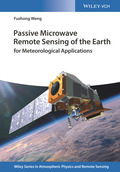Passive Microwave Remote Sensing of the Earth
for Meteorological Applications
Wiley Series in Atmospheric Physics and Remote Sensing

1. Edition August 2017
XIV, 363 Pages, Hardcover
170 Pictures
Monograph
Short Description
This book covers the fundamentals of satellite microwave instrument calibration, remote sensing sciences and algorithms, as well as the applications of the satellite microwave observations in weather and climate research.
Essential to the understanding of global climate change and improved weather forecasts is the gathering of basic data of variables such as temperature, pressure, wind, and the distribution of water vapor, clouds, and other active constituents. The microwave frequency region plays a special role in the remote sensing of these variables because microwave signals penetrate through clouds and therefore provide capabilities of retrieving the parameters under all weather conditions.
New instruments provide unprecedented observations of the Earth's environment and offer many unique opportunities to further improve our understanding of weather and climate changes and to benefit significantly the numerical weather prediction. Knowledge of the satellite instrument in-orbit performances is important for better utilization of satellite data in numerical weather prediction models.
The topics covered in this book are the fundamentals of satellite microwave instrument calibration, remote sensing sciences and algorithms, and the applications of satellite microwave observations in weather and climate research. The reader gains a full knowledge of satellite microwave instrument calibration and fundamental remote sensing theory and helpful hints for applying microwave data in research and operations, of particular interest to those involved in meteorology and climate research.
*Review of US and international operational satellite programs that have microwave imagers and sounders on board and their major mission goals in the Earth environmental monitoring
Chapter 2: Satellite Microwave Radiometer System
Introduce microwave radiometer system components,
Radiometric linear and nonlinear calibration,
Antenna theory including characterization of APC gain, spill-over from side-lobe and polarization,
Backus-Gilbert resampling for noise reduction and foot print matching
On-orbit absolute calibration from GPSRO data, and characterization of scan angle correction.
Chapter 3: Atmospheric Absorption and Scattering
Optical parameters used in atmospheric remote sensing
Absorption spectrum from oxygen and water vapor, Zeeman splitting
Scattering properties from cloud hydrometeors and approximation form on phase matrix and Rayleigh approximation,
Chapter 4: Microwave Radiative Transfer Theory
Requirements for microwave radiative transfer (e.g. full vector model)
General radiative transfer modeling and discrete ordinate method
Approximation leading to emission and scattering based radiative transfer used for remote sensing
Ocean surface emissivity model (two-scale approximation)
Land surface emissivity model including snow dense medium approach
Chapter 5: Microwave Atmospheric and Environmental Remote Sensing
Atmospheric temperature and water profile, cloud liquid/ice,
Land surface parameters including surface emissivity, temperature, soil moisture and snow cover
Ocean surface parameters including SST and SSW, sea ice concentration
Global radio-frequency interference (RFI) using normalized PCA and double NPCA
Chapter 6: Applications of Microwave Data in Weather Event Monitoring and Forecasts
Hurricane and typhoon warm core analysis
Balanced wind analysis from microwave sounders
Satellite data assimilation and quality control
Impacts of satellite data assimilation on hurricane track and intensity forecasts
Flood monitoring
Chapter 7: Applications of Microwave Data in Climate Research
Requirements for monitoring climate trends from satellites
Cross calibration of microwave data for fundamental climate data record
Analysis of climate trend of microwave sounder and imager


